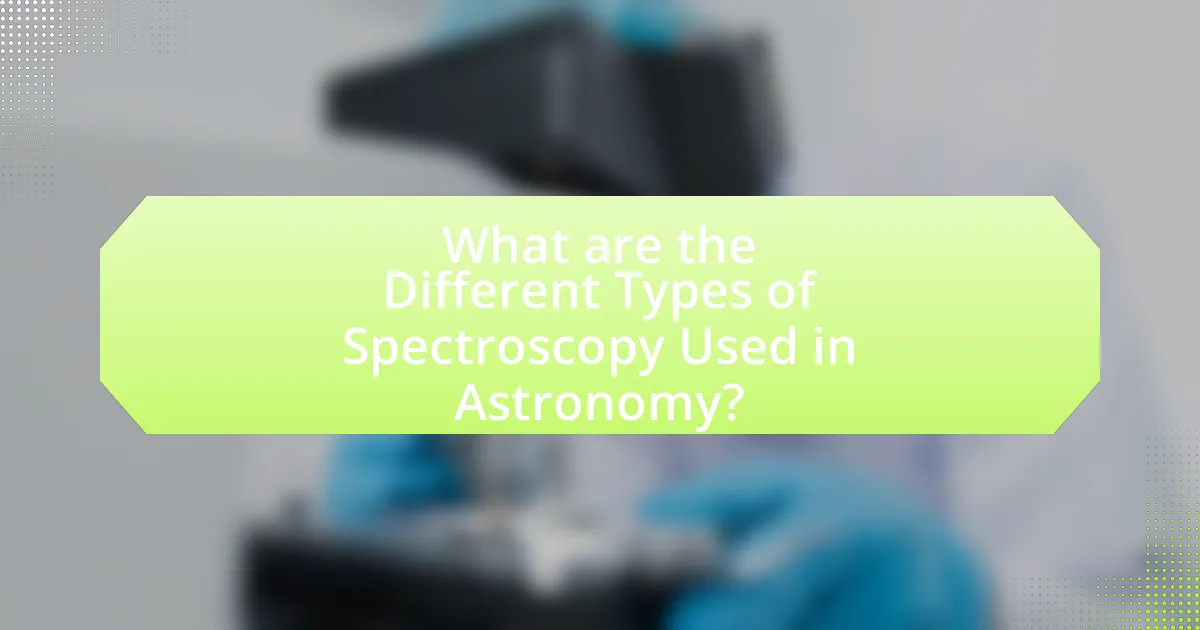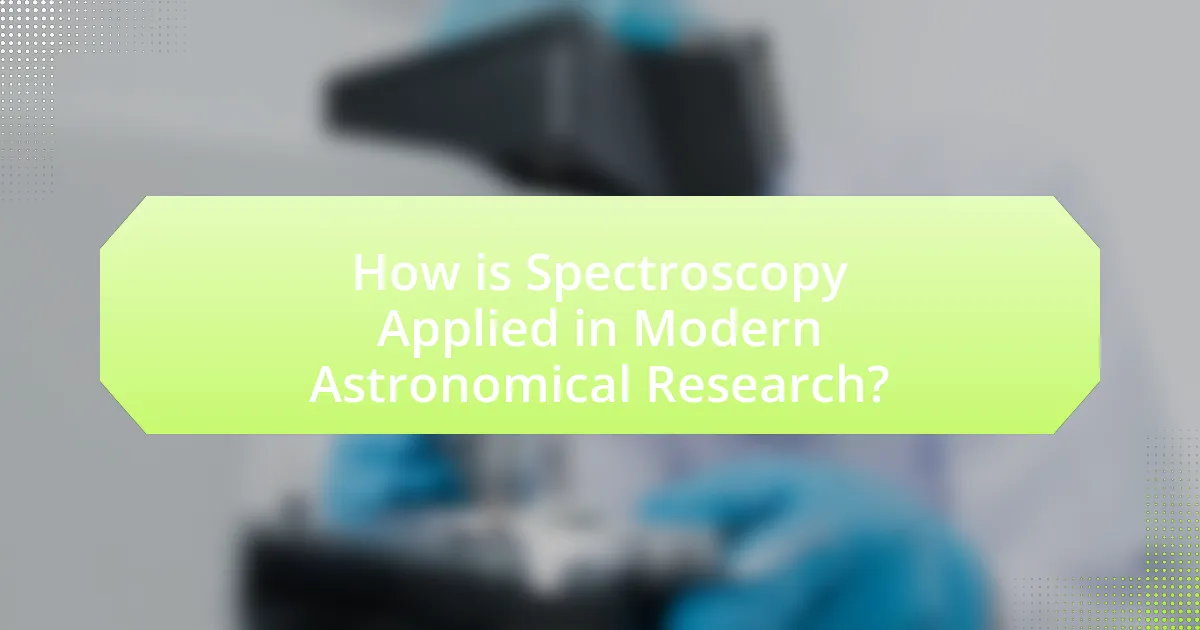Spectroscopy is the study of the interaction between light and matter, playing a crucial role in astronomy by enabling the analysis of celestial objects’ composition, temperature, density, and motion. This article explores the significance of spectroscopy in understanding stars, galaxies, and exoplanets, detailing various types of spectroscopy, including optical, infrared, and radio spectroscopy, and their applications in astronomical research. Key discoveries facilitated by spectroscopy, such as the identification of chemical elements in stars and the measurement of the universe’s expansion, are highlighted, along with the challenges and advancements in spectroscopy techniques. The article emphasizes the importance of modern technologies and methodologies in enhancing the accuracy and reliability of spectroscopic observations in the field of astronomy.

What is Spectroscopy and Why is it Important in Astronomy?
Spectroscopy is the study of the interaction between light and matter, allowing astronomers to analyze the composition, temperature, density, and motion of celestial objects. It is important in astronomy because it provides critical information about the physical properties of stars, galaxies, and other astronomical phenomena. For instance, by examining the spectral lines of light emitted or absorbed by an object, astronomers can determine its chemical composition and velocity through the Doppler effect. This technique has been fundamental in discovering the expansion of the universe, as evidenced by Edwin Hubble’s observations of redshift in distant galaxies.
How does spectroscopy contribute to our understanding of celestial bodies?
Spectroscopy contributes to our understanding of celestial bodies by allowing scientists to analyze the light emitted or absorbed by these objects, revealing their composition, temperature, density, and motion. This technique enables the identification of specific elements and molecules present in stars and planets, as different substances produce unique spectral lines. For instance, the detection of hydrogen and helium in stars has been confirmed through their characteristic absorption lines, which supports theories about stellar formation and evolution. Additionally, spectroscopy helps determine the redshift of distant galaxies, providing insights into the universe’s expansion and the Big Bang theory.
What are the fundamental principles of spectroscopy in an astronomical context?
The fundamental principles of spectroscopy in an astronomical context involve the analysis of light emitted, absorbed, or scattered by celestial objects to determine their composition, temperature, density, mass, distance, luminosity, and relative motion. Spectroscopy relies on the interaction of electromagnetic radiation with matter, where different elements and compounds produce unique spectral lines due to their atomic structure. This principle is evidenced by the identification of hydrogen in stars through its characteristic spectral lines, as first demonstrated by Joseph von Fraunhofer in the early 19th century. The Doppler effect further enhances this analysis by allowing astronomers to measure the redshift or blueshift of light from moving objects, providing insights into the universe’s expansion.
How do different types of spectroscopy apply to various astronomical phenomena?
Different types of spectroscopy apply to various astronomical phenomena by allowing scientists to analyze the light emitted, absorbed, or scattered by celestial objects, revealing their composition, temperature, density, mass, distance, luminosity, and relative motion. For instance, absorption spectroscopy helps identify the chemical elements present in stars by examining the specific wavelengths of light that are absorbed, while emission spectroscopy reveals the elements present in nebulae through the light they emit at characteristic wavelengths. Additionally, Doppler spectroscopy measures the shifts in spectral lines to determine the velocity of stars and galaxies, providing insights into their movement and the expansion of the universe. These applications are supported by numerous observations, such as the identification of hydrogen and helium in stars through their spectral lines, which confirms the predictions of stellar nucleosynthesis.
What key discoveries in astronomy have been made possible through spectroscopy?
Key discoveries in astronomy made possible through spectroscopy include the identification of the chemical composition of stars, the measurement of their temperatures, and the determination of their velocities. Spectroscopy allows astronomers to analyze the light emitted or absorbed by celestial objects, revealing specific spectral lines that correspond to different elements and compounds. For instance, the discovery of hydrogen in the Sun’s spectrum by Joseph von Fraunhofer in the early 19th century marked a significant advancement in understanding stellar composition. Additionally, the Doppler effect observed in spectral lines has enabled the measurement of the expansion of the universe, as demonstrated by Edwin Hubble’s observations in the 1920s. These findings underscore the critical role of spectroscopy in advancing our knowledge of the universe.
How has spectroscopy advanced our knowledge of the composition of stars?
Spectroscopy has significantly advanced our knowledge of the composition of stars by allowing astronomers to analyze the light emitted or absorbed by stars, revealing their elemental makeup. Through the use of spectroscopy, scientists can identify specific spectral lines corresponding to different elements, such as hydrogen, helium, and heavier elements, which are present in stellar atmospheres. This technique has enabled the determination of stellar temperatures, densities, and compositions, leading to the classification of stars into various types based on their spectra. For instance, the discovery of the hydrogen spectrum by Balmer in the early 20th century provided crucial insights into the abundance of hydrogen in stars, which constitutes about 74% of the universe’s elemental mass. Additionally, spectroscopy has facilitated the study of stellar evolution and the processes occurring within stars, enhancing our understanding of their life cycles and the nucleosynthesis of heavier elements.
What role does spectroscopy play in the study of exoplanets?
Spectroscopy plays a crucial role in the study of exoplanets by allowing scientists to analyze the light emitted or absorbed by these distant worlds. This technique enables the identification of chemical compositions, atmospheric conditions, and potential habitability of exoplanets. For instance, when light from a star passes through an exoplanet’s atmosphere, specific wavelengths are absorbed by gases, creating a unique spectral fingerprint. This method has been instrumental in detecting molecules such as water vapor, carbon dioxide, and methane in exoplanetary atmospheres, providing insights into their physical and chemical properties. The Hubble Space Telescope and the James Webb Space Telescope have utilized spectroscopy to gather data on exoplanets, confirming the presence of these key molecules and enhancing our understanding of their environments.

What are the Different Types of Spectroscopy Used in Astronomy?
The different types of spectroscopy used in astronomy include optical spectroscopy, infrared spectroscopy, ultraviolet spectroscopy, radio spectroscopy, and X-ray spectroscopy. Optical spectroscopy analyzes light from celestial objects to determine their composition, temperature, and motion. Infrared spectroscopy detects thermal radiation, revealing information about cooler objects like dust clouds and planets. Ultraviolet spectroscopy studies high-energy processes in stars and galaxies, providing insights into their physical conditions. Radio spectroscopy examines radio waves emitted by celestial bodies, allowing astronomers to study molecular clouds and cosmic background radiation. X-ray spectroscopy focuses on high-energy emissions from hot gas in galaxy clusters and black holes, helping to understand extreme environments in the universe. Each type of spectroscopy plays a crucial role in expanding our knowledge of the cosmos.
How do optical and infrared spectroscopy differ in their applications?
Optical and infrared spectroscopy differ primarily in their applications due to the wavelengths of light they utilize and the types of information they provide. Optical spectroscopy, which operates in the visible range, is commonly used to analyze the composition and physical properties of celestial objects, such as stars and galaxies, by examining their emitted light. This technique is effective for determining elemental abundances and temperature through absorption and emission lines.
In contrast, infrared spectroscopy operates in the infrared range and is particularly useful for studying cooler astronomical objects, such as dust clouds, planets, and molecular gases, which emit radiation primarily in the infrared spectrum. This method allows astronomers to investigate molecular structures and dynamics, as well as to observe objects obscured by dust that are not visible in optical wavelengths.
The distinction in applications is supported by the fact that many astronomical phenomena, such as star formation and the presence of organic molecules in space, are best observed in the infrared, while the optical spectrum is more suited for studying hotter, luminous objects.
What are the advantages of using infrared spectroscopy in astronomical observations?
Infrared spectroscopy offers significant advantages in astronomical observations by enabling the detection of cooler celestial objects and the analysis of molecular compositions. This technique allows astronomers to observe objects that emit primarily in the infrared spectrum, such as stars in their formation stages, distant galaxies, and planetary atmospheres, which are often obscured by dust in visible light. Additionally, infrared spectroscopy provides insights into the chemical makeup of these objects, revealing the presence of complex molecules and ices that are crucial for understanding the formation of stars and planets. The ability to penetrate dust clouds and gather data on temperature and composition makes infrared spectroscopy an essential tool in modern astronomy.
How does optical spectroscopy enhance our understanding of stellar atmospheres?
Optical spectroscopy enhances our understanding of stellar atmospheres by allowing astronomers to analyze the light emitted or absorbed by stars, revealing their chemical composition, temperature, density, and motion. This technique involves measuring the spectrum of light, which contains distinct absorption and emission lines corresponding to specific elements and molecules present in the star’s atmosphere. For instance, the presence of hydrogen, helium, and heavier elements can be identified through their unique spectral lines, providing insights into the star’s evolutionary stage and physical conditions. Additionally, optical spectroscopy enables the determination of stellar velocities through the Doppler effect, which helps in understanding stellar dynamics and interactions within galaxies.
What is the significance of radio spectroscopy in astronomy?
Radio spectroscopy is significant in astronomy because it allows scientists to analyze the composition, temperature, density, and motion of celestial objects through the radio waves they emit or absorb. This technique has led to the discovery of various astronomical phenomena, such as the cosmic microwave background radiation, which provides evidence for the Big Bang theory. Additionally, radio spectroscopy has enabled the identification of molecules in space, including water and complex organic compounds, which are crucial for understanding the chemistry of the universe and the potential for life beyond Earth.
How does radio spectroscopy contribute to the study of cosmic microwave background radiation?
Radio spectroscopy significantly contributes to the study of cosmic microwave background radiation by allowing scientists to analyze the frequency and intensity of the radiation emitted from the early universe. This technique enables the detection of minute variations in the cosmic microwave background, which provides insights into the universe’s temperature fluctuations and density variations shortly after the Big Bang. For instance, the Wilkinson Microwave Anisotropy Probe (WMAP) utilized radio spectroscopy to map these fluctuations, revealing critical information about the universe’s age, composition, and expansion rate. Such precise measurements have confirmed the predictions of the Big Bang theory and enhanced our understanding of cosmic evolution.
What discoveries have been made using radio spectroscopy techniques?
Radio spectroscopy techniques have led to significant discoveries in astronomy, including the detection of cosmic microwave background radiation, which provides evidence for the Big Bang theory. This radiation was first observed by Arno Penzias and Robert Wilson in 1965, confirming the existence of the early universe and its expansion. Additionally, radio spectroscopy has enabled the identification of various molecules in space, such as water, carbon monoxide, and complex organic compounds, contributing to our understanding of star formation and the chemical processes in interstellar clouds. These findings have been crucial in advancing knowledge about the universe’s structure and evolution.

How is Spectroscopy Applied in Modern Astronomical Research?
Spectroscopy is applied in modern astronomical research to analyze the light emitted or absorbed by celestial objects, allowing scientists to determine their composition, temperature, density, mass, distance, luminosity, and relative motion. By examining the spectral lines in the light from stars and galaxies, astronomers can identify the presence of specific elements and molecules, which provides insights into the physical and chemical properties of these objects. For instance, the detection of hydrogen and helium in stars has been crucial for understanding stellar evolution. Additionally, spectroscopy enables the measurement of redshifts, which helps in determining the expansion rate of the universe, as evidenced by the work of Edwin Hubble in the early 20th century.
What technologies are currently used in astronomical spectroscopy?
Astronomical spectroscopy currently utilizes technologies such as CCD (Charge-Coupled Device) detectors, echelle spectrographs, and fiber optic spectrographs. CCD detectors are widely used for their high sensitivity and ability to capture faint light from distant celestial objects, enabling detailed spectral analysis. Echelle spectrographs allow for high-resolution spectroscopy by dispersing light into multiple orders, which is essential for studying the chemical composition and physical properties of stars and galaxies. Fiber optic spectrographs facilitate the collection of light from multiple sources simultaneously, improving efficiency in observational campaigns. These technologies collectively enhance our understanding of the universe by providing critical data on the composition, temperature, density, and motion of astronomical objects.
How do advancements in detector technology improve spectroscopy results?
Advancements in detector technology significantly enhance spectroscopy results by increasing sensitivity, resolution, and speed of data acquisition. Improved detectors, such as charge-coupled devices (CCDs) and superconducting nanowire single-photon detectors (SNSPDs), allow for the detection of fainter signals and finer spectral details. For instance, modern CCDs can achieve quantum efficiencies exceeding 90%, enabling the capture of weak astronomical signals that were previously undetectable. Additionally, advancements in detector array technology facilitate simultaneous measurements across a broader wavelength range, improving the efficiency of spectral data collection. These enhancements lead to more accurate identification of chemical compositions and physical conditions in astronomical objects, ultimately advancing our understanding of the universe.
What role do space-based observatories play in enhancing spectroscopy data?
Space-based observatories significantly enhance spectroscopy data by providing unobstructed views of celestial objects, free from Earth’s atmospheric interference. This allows for more accurate measurements of light spectra, which are crucial for determining the composition, temperature, density, and motion of astronomical objects. For instance, the Hubble Space Telescope has enabled detailed spectroscopic studies of distant galaxies, revealing their chemical makeup and evolutionary history. Additionally, missions like the James Webb Space Telescope are designed to capture infrared spectra, which can unveil the presence of water, organic molecules, and other key elements in exoplanet atmospheres, thus advancing our understanding of potential habitability.
What challenges do astronomers face when using spectroscopy?
Astronomers face several challenges when using spectroscopy, primarily related to atmospheric interference, instrument limitations, and data interpretation complexities. Atmospheric interference, such as absorption and scattering of light by Earth’s atmosphere, can distort spectral data, making it difficult to obtain accurate measurements. Instrument limitations, including resolution and sensitivity constraints, can hinder the ability to detect faint signals or resolve closely spaced spectral lines. Additionally, data interpretation is complicated by the need to distinguish between various sources of light and to account for factors like redshift and Doppler effects, which can alter the observed spectra. These challenges necessitate advanced techniques and technologies to enhance the reliability and accuracy of spectroscopic analyses in astronomical research.
How do atmospheric conditions affect ground-based spectroscopy observations?
Atmospheric conditions significantly impact ground-based spectroscopy observations by altering the transmission of light and introducing noise. Variations in humidity, temperature, and atmospheric pressure can lead to changes in the refractive index of air, affecting the spectral lines observed. For instance, water vapor absorbs specific wavelengths, which can obscure or distort the spectral data collected from celestial objects. Additionally, turbulence in the atmosphere can cause fluctuations in light intensity, resulting in broadening of spectral lines and reducing the resolution of observations. Studies have shown that these atmospheric effects can lead to systematic errors in the measurement of elemental abundances and redshifts, thereby influencing the accuracy of astronomical analyses.
What are the limitations of current spectroscopy techniques in astronomy?
Current spectroscopy techniques in astronomy face limitations such as sensitivity to faint sources, resolution constraints, and atmospheric interference. These techniques often struggle to detect weak signals from distant celestial objects, which can lead to incomplete data. For instance, ground-based spectroscopy is significantly affected by Earth’s atmosphere, causing absorption and scattering of light, which can distort spectral data. Additionally, the resolution of current instruments may not be sufficient to distinguish closely spaced spectral lines, limiting the ability to analyze complex chemical compositions in astronomical objects. These limitations hinder the comprehensive understanding of the universe’s composition and dynamics.
What best practices can astronomers follow to optimize spectroscopy results?
Astronomers can optimize spectroscopy results by ensuring high-quality data acquisition through careful calibration and appropriate instrument settings. Calibration involves using standard stars to correct for instrumental effects, which enhances the accuracy of spectral measurements. Additionally, selecting the right exposure times and minimizing background noise are crucial for obtaining clear spectra. Research indicates that using advanced techniques such as adaptive optics can significantly improve resolution and signal-to-noise ratios, leading to more precise spectral analysis. Furthermore, employing software tools for data reduction and analysis, such as IRAF or PyRAF, allows astronomers to efficiently process and interpret spectral data, thereby maximizing the scientific yield from observations.
